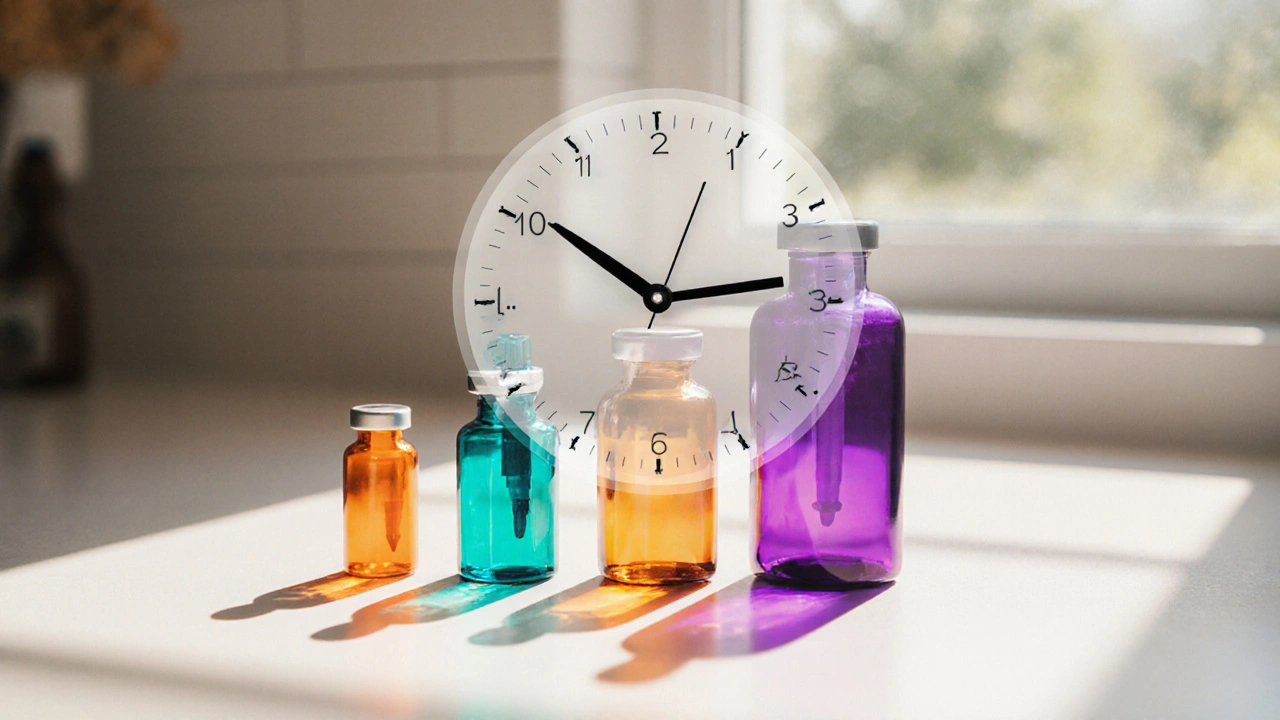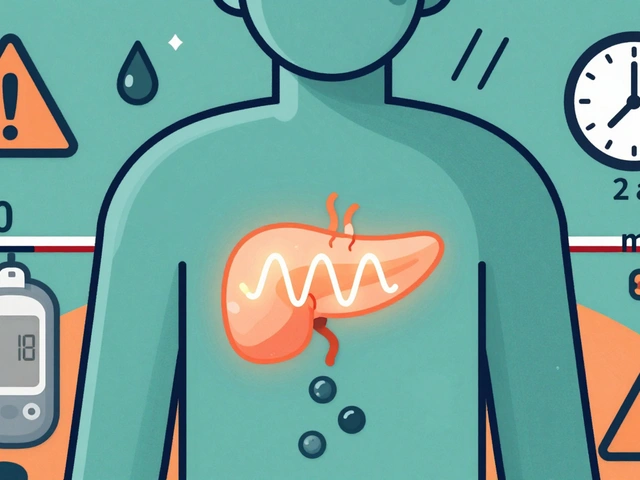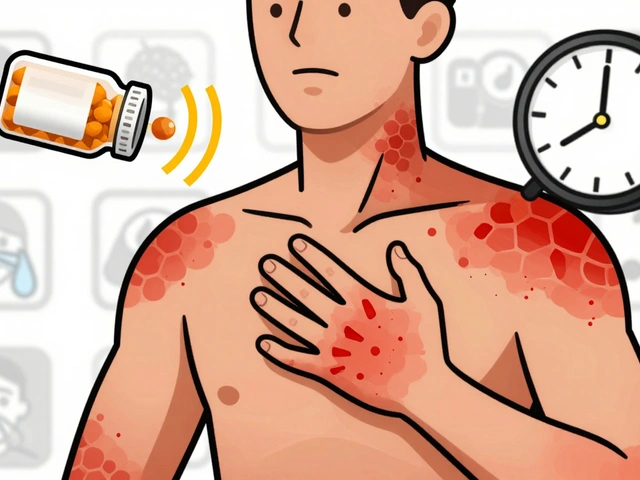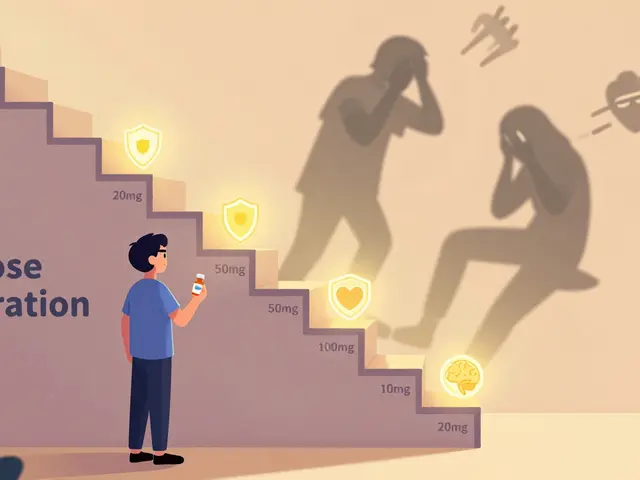
Insulin Type Comparison Guide
Compare the characteristics of different insulin types to understand how they work in diabetes management.
| Category | Onset | Peak | Duration | Typical Use |
|---|---|---|---|---|
| Rapid-acting analog | 5–15 min | 1–2 hr | 3–5 hr | Mealtime bolus |
| Short-acting (regular) | 30 min | 2–3 hr | 5–8 hr | Meals, occasional correction |
| Intermediate-acting | 1–2 hr | 4–12 hr | 12–18 hr | Baseline (basal) coverage |
| Long-acting (glargine, degludec) | 1 hr | No pronounced peak | 24 hr (glargine) or >42 hr (degludec) | Once-daily basal insulin |
Selected Insulin Details
Quick Takeaways
- Insulin is the key hormone that moves glucose from the blood into cells.
- There are four main categories of insulin - rapid‑acting, short‑acting, intermediate‑acting, and long‑acting.
- Basal‑bolus regimens, pumps, and hybrid closed‑loop systems each suit different lifestyle needs.
- Dosing follows carbohydrate counting, correction factors, and regular blood glucose monitoring.
- Preventing hypoglycemia and storing insulin properly keep treatment safe and effective.
What Is Insulin?
Insulin is a peptide hormone produced by the pancreas that enables body cells to absorb blood glucose for energy. In people without diabetes, insulin is released automatically whenever glucose levels rise after a meal. When the hormone isn’t available or can’t work properly, glucose builds up in the bloodstream, leading to the classic symptoms of diabetes.
Understanding insulin is the first step toward mastering diabetes management.
How Insulin Regulates Blood Sugar
After you eat, carbohydrates break down into glucose, which enters the blood. Blood glucose triggers beta cells in the pancreas to release insulin. The hormone binds to receptors on muscle, fat, and liver cells, opening channels that pull glucose inside. Once inside, glucose is either used right away for energy or stored as glycogen for later.
If insulin is missing (as in Type 1 diabetes) or the cells become resistant (as in Type 2 diabetes), glucose stays in the bloodstream, causing chronic hyperglycemia. Over time, high glucose damages blood vessels, nerves, kidneys, and eyes.

Types of Insulin Used in Diabetes
| Category | Onset | Peak | Duration | Typical Use |
|---|---|---|---|---|
| Rapid‑acting analog | 5-15 min | 1-2 hr | 3-5 hr | Mealtime bolus |
| Short‑acting (regular) | 30 min | 2-3 hr | 5-8 hr | Meals, occasional correction |
| Intermediate‑acting | 1-2 hr | 4-12 hr | 12-18 hr | Baseline (basal) coverage |
| Long‑acting (glargine, degludec) | 1 hr | No pronounced peak | 24 hr (glargine) or >42 hr (degludec) | Once‑daily basal insulin |
Choosing the Right Insulin Regimen
Most adults with diabetes fall into one of three regimen families:
- Basal‑bolus injections: a long‑acting basal dose once or twice a day, plus rapid‑acting bolus doses before meals.
- Insulin pump therapy: a small device delivers rapid‑acting insulin continuously (basal) and on‑demand (bolus). Insulin pump mimics natural secretion patterns.
- Hybrid closed‑loop systems: combine a pump with a continuous glucose monitor (CGM) and algorithm that auto‑adjusts basal rates.
Factors influencing choice include daily routine, willingness to inject multiple times, insurance coverage, and personal comfort with technology.
How to Dose Insulin Safely
Accurate dosing hinges on three calculations: carbohydrate coverage, correction factor, and total daily dose (TDD). A step‑by‑step guide looks like this:
- Determine your carb‑to‑insulin ratio (e.g., 1 unit per 10g carbs). This ratio is often personalized by a diabetes educator.
- Count the grams of carbs on your plate. Multiply by the ratio to get the bolus amount for the meal.
- Check your current blood glucose (or CGM reading). If it’s above your target, calculate a correction dose using your insulin sensitivity factor (ISF), typically 1 unit lowers glucose by 30-50mg/dL.
Correction dose = (Current-Target)÷ISF. - Add the carb bolus and correction dose together. Round to the nearest half‑unit if your pen allows.
- For basal insulin, use the total daily dose divided by two (if you take twice‑daily) or a flat dose for once‑daily long‑acting insulins.
Always re‑check the calculation before injecting. If you’re unsure, a quick call to your healthcare team can prevent mistakes.

Common Challenges & Tips
Even with a solid plan, real‑life situations throw curveballs. Here are four frequent issues and how to handle them:
- Hypoglycemia (low blood sugar): Symptoms include shakiness, sweating, and confusion. Treat immediately with 15g of fast carbs (e.g., glucose tablets, juice). Re‑check after 15 minutes; repeat if needed.
- Insulin storage: Keep unopened vials refrigerated (2‑8°C). Once in use, pens can be stored at room temperature for up to 28days. Avoid exposing insulin to extreme heat or direct sunlight.
- Meal timing: Inject rapid‑acting insulin 5-10 minutes before eating. If you’re delayed, a smaller dose may be safer to avoid lows.
- Exercise: Physical activity boosts insulin sensitivity, often requiring a reduction in bolus dose or extra carbs beforehand. A common rule is to consume 15-30g carbs for every 30minutes of moderate activity.
Integrating Insulin with Lifestyle
Insulin isn’t a prison‑sentence; it’s a tool that works best when paired with healthy habits.
- Balanced meals: Pair carbs with protein and fiber to slow glucose spikes, reducing the need for high bolus doses.
- Regular monitoring: Whether you use a finger‑stick meter or a CGM, frequent data helps you spot trends and adjust doses before problems arise.
- Sleep hygiene: Overnight basal insulin may need tweaking if you experience dawn phenomenon (early‑morning glucose rise). A small increase in basal rate at 2‑3am can smooth the curve.
- Stress management: Hormones like cortisol raise blood glucose. On stressful days, consider a modest correction dose and stay hydrated.
Frequently Asked Questions
Can I stop using insulin if my diet improves?
For people with Type 1 diabetes, insulin is lifelong because the pancreas no longer produces it. In Type 2 diabetes, some individuals can reduce or stop insulin with significant weight loss, diet changes, and oral agents, but any change must be doctor‑guided to avoid dangerous highs.
What’s the difference between a pump and a pen?
Pens deliver a set dose with each injection, typically 4‑6 times a day. Pumps continuously infuse rapid‑acting insulin, providing a basal rate that can be adjusted minute‑by‑minute, plus on‑demand boluses. Pumps reduce the number of skin punctures but require more technical upkeep.
How often should I rotate injection sites?
Rotate within a chosen region (abdomen, thigh, buttock, upper arm) every 1‑2 days. Avoid injecting into scar tissue, lipohypertrophy, or areas with bruises. Proper rotation improves insulin absorption and reduces pain.
Why does my blood sugar rise in the early morning?
The "dawn phenomenon" occurs when hormones like growth hormone and cortisol surge overnight, prompting the liver to release glucose. Adjusting basal insulin timing or increasing the early‑morning basal rate can blunt this rise.
Is it safe to exercise after taking rapid‑acting insulin?
Yes, but plan ahead. Reduce the bolus dose by 25‑50% for moderate activity or have fast carbs handy. Monitoring glucose before, during, and after exercise helps you fine‑tune the adjustments.






9 Comments
I appreciate the thorough breakdown of insulin types; it really helps demystify the options for newcomers. The balance between rapid‑acting and basal insulin is crucial for stable glucose control. Thanks for laying it out in a clear, digestible way.
Fast‑acting insulin works in minutes not hours
You're right about the kinetic profiles, but let’s dig deeper into the pharmacodynamics for a comprehensive view. Rapid‑acting analogs such as lispro or aspart have a sub‑minute onset that aligns with postprandial glucose excursions, minimizing lag. Their peak at 1‑2 hours delivers a swift bolus effect, making them ideal for carbohydrate‑rich meals. In contrast, short‑acting regular insulin exhibits a 30‑minute latency and a broader 2‑3 hour peak, which can be advantageous for slower digesting foods. Intermediate‑acting NPH, with its pronounced peak between 4‑12 hours, serves as a basal backbone but introduces variability due to its pronounced peak‑trough cycle. Long‑acting analogs like glargine and degludec flatten the basal curve, offering a near‑constant insulin level and reducing nocturnal hypoglycemia risk. The choice between these agents hinges on patient lifestyle, meal timing, and hypoglycemia susceptibility. Moreover, the total daily dose (TDD) calculation remains foundational; dividing TDD by two typically yields a starting basal dose, then fine‑tuning based on fasting glucose trends. Carbohydrate‑to‑insulin ratios must be individualized, factoring in insulin sensitivity factor (ISF) to calibrate correction doses. For instance, an ISF of 45 mg/dL per unit suggests that a 150 mg/dL reading above target would require roughly three units of correction. Integration with continuous glucose monitoring (CGM) data enables dynamic adjustments, especially during physical activity where insulin sensitivity spikes. Exercise protocols often recommend a 25‑50% reduction in bolus or pre‑exercise carbohydrate loading of 15‑30 grams per 30 minutes of activity. Additionally, site rotation mitigates lipohypertrophy, enhancing insulin absorption consistency. Proper storage-refrigeration for unopened vials, room temperature for pens up to 28 days-preserves potency and prevents efficacy loss. Lastly, patient education on the dawn phenomenon can prompt basal dose tweaks around 2‑3 AM to smooth early‑morning glucose surges. In sum, a nuanced understanding of each insulin’s kinetic and dynamic properties, coupled with personalized dosing algorithms, optimizes glycemic outcomes.
The table summarizing onset, peak, and duration is particularly useful for quick reference. Precise language helps avoid misunderstandings about timing.
Oh great, another endless spreadsheet of numbers. Because we all have time to memorize pharmacokinetics between coffee breaks.
This guide offers a solid framework for clinicians to tailor insulin regimens. The step‑by‑step dosing algorithm is clear and evidence‑based. I recommend sharing it with patients during education sessions.
Wow, thanks for the info 😊 will definitely keep this in mind when adjusting my doses!
Loving the friendly tone of this post-makes a heavy topic feel more approachable. Keep up the good work!
Ah, because reading a clinical guide is exactly how I wanted to spend my weekend. Truly enlightening.